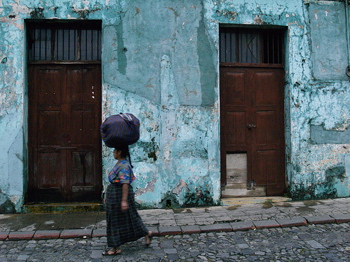
Photo by Amauri Aguiar and used under Creative Commons license
On International Day of the World's Indigenous People, there is a celebration of indigenous peoples and how they express themselves through their artistic creations. These groups, not only in Guatemala, but all across the world often face discrimination, extreme poverty and social marginalization on a daily basis. However, this post seeks to show how indigenous peoples in Guatemala are sharing their artistic expressions.
Comalapa is a special place for indigenous people in Guatemala, famous for their painters and intellectuals respected all over the World:
Todo comenzó durante los años 30 del siglo pasado, cuando Andrés Curruchiche se interesó en el arte de pintar al óleo, y su creatividad le dio la oportunidad de exhibir sus trabajos en Estados Unidos. En aquel país del Norte, Curruchiche consiguió superar el récord de 123 mil visitantes que el pintor y escultor español Pablo Ruiz Picasso había registrado en exhibiciones de arte. El éxito que recabó el pintor comalapense a nivel mundial e internacional con sus trabajos primitivistas lo comprometió con su pueblo, por lo que comenzó a enseñarle a las nuevas generaciones. De esa cuenta, surge una segunda generación integrada por 15 pintores primitivistas y en los años 80 nace la tercera; pero esta vez compuesta por nueve mujeres que optaron por el estilo surrealista (pinturas de paisajes con mezcla de primitivismo)".
It all started during the 1930s, when Andrés Curruchiche was interested in oil paintings, and his creativity gave him the opportunity to exhibit their works in the United States. In that northern country, Curruchiche broke the record of 123,000 visitors that the painter Pablo Picasso had registered in his exhibitions. The success of the Comalapan painter worldwide and nationally with his primitivist art committed him with his peoples, so he started teaching future generations. The second generation were 15 painters, the third generation included women, and they changed their primitivist style for a surrealist style (a mix of landscapes and primitivism).
Here is a link to Naiftenango [es], a collective blog devoted to the “Naïf or primitivist art” in Guatemala, where the team filmed a short video on the Curruchiche gallery, led nowadays by his grandaughter, a painter too.
It is important to understand that while many indigenous groups share similar problems, there are different groups within Guatemala. Some of them have even been rivals in the past and some do not speak the same language. However, street theater has managed to connect two indigenous communities and brought youth to work together. These groups are supported by "La Cambalacha ", an organization helping the indigenous communities near Atitlan:
El grupo se integra por jóvenes Kakchikeles de San Marcos La Laguna y jóvenes Tz´utujiles de San Pablo La Laguna. Estas dos comunidades tienen conflicto entre sí desde hace siglos, por lo que el trabajo conjunto de los y las jóvenes da un valor muy especial al proceso que vivieron durante el montaje de la obra, como también a la presentación de la obra ante las comunidades.
The group is formed by Kakchikel youth from San Marcos la Laguna and Tzutujl youth from San Pablo La Laguna. While the two communities have been in conflict for centuries, this is a special effort, because of the time that they shared during the play practices, and also when they performed it for their communities.
But perhaps the most impressive, challenging and creative expression of art and identity for indigenous peoples in Guatemala is their clothing. Beautiful handmade blouses are called huipiles that many women still wear. You cannot find two identical pieces, and women express themselves creating new patterns, new styles that tell stories of birds and flowers, like a walking gallery:
As Supango [es] points out:
Detengámonos y contemplemos los pequeños e innumerables detalles de la indumentaria indigena, probablemente expanda nuestra visión. Busquemos más belleza y riqueza, y no esperemos que algún extranjero nos las señale.
Let's stop and reflect on the small and countless details of indigenous clothing, and it will probably open our mind. Let's discover more beauty and richness, and let's not wait for someone from abroad let us see that.






